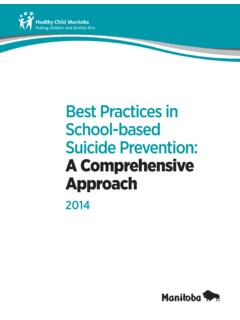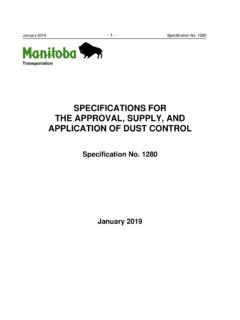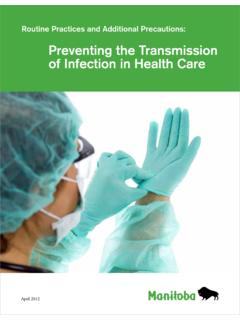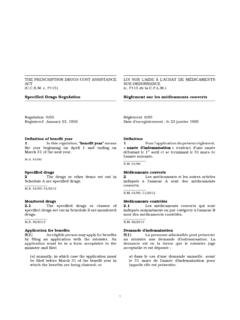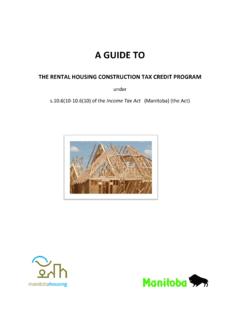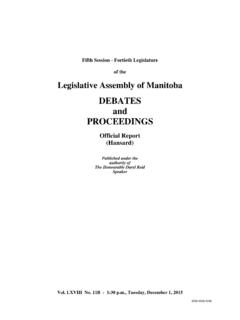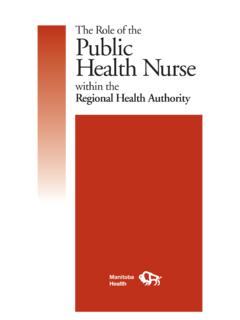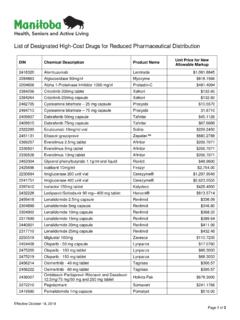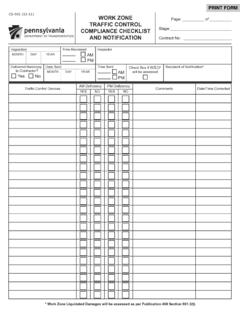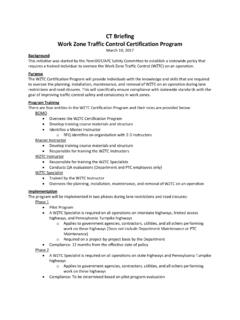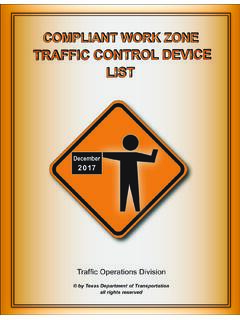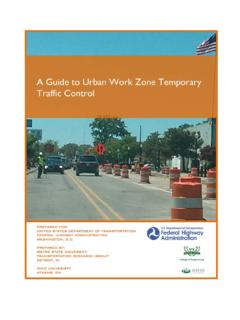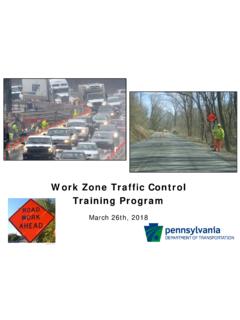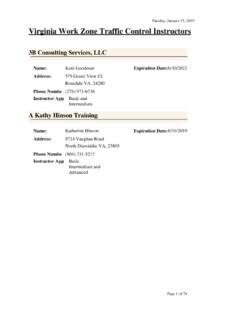Transcription of Work Zone Traffic Control Manual - Manitoba
1 Provincial Trunk HighwaysProvincial RoadsandInfrastructure andTransportationTraffic EngineeringWork Zone Traffic Control ManualManitoba Infrastructure and TransportationFINESSPEEDDOUBLECONSTRUCTI ONDESIGNATEDZONE2015 work Zone Traffic Control Manual Interim Release In December, 2013, the Government of Manitoba passed Highway Traffic Act (HTA) amendments that required the establishment of Designated Construction zones for prescribed projects and prohibited the use of the 60 When Passing Workers sign on all highways throughout Manitoba . As a result of the introduction of these regulations the work Zone Policies and Traffic Management Plans (TMP s) contained in Manitoba Infrastructure and Transportation s work Zone Traffic Control Manual required significant revision to comply with the HTA amendments. This interim release of the 2015 work Zone Traffic Control Manual is the second step in providing an updated resource for contractors, MIT personal, utility companies, and others who carry out work on provincial highways.
2 This initial release includes a full complement of updated TMP s providing the minimum standard for the protection of road users and workers on Manitoba s highways. In addition four updated policies reference in the TMP s are also being released at this time. It is anticipated that the entire 2015 Workzone Traffic Control Manual with a full complement of updated policies will be ready for release later this year. In the interim, users are asked to reference the policies in the 2013 Manual for general guidance keeping in mind that the 2013 changes to the HTA have not been reflected in these documents. Some of the key changes in 2015 Manual include: The definitions of Short Term and Long Term work have been revised to align with DCZ legislation. Short Term work is any work less than 4 hours in duration. Long term work is any work more than 4 hours in duration.
3 As outlined in Policy 915-A-7, Manitoba Infrastructure and Transportation requires that all work zones within a declared provincial highway or provincial road right-of-way be established as a Designated Construction Zone if the duration of the work is more than 4 hours. The 4 hour time limit shall be the sole criteria used to determine if a DCZ will be established. The location of the work within the right-of-way, the nature of the roadway surface, and the posted speed limit on the highway shall not be determining factors for the establishment of DCZ s on provincial highways and roads. The decision to reduce speeds within a work zone should only be taken after a risk analysis has been conducted. Specific guidelines governing the establishment of regulatory speed reductions on provincial highways are provided in Policy 915-A-6.
4 As outlined in Policy 915-E-1, mandatory speed reductions to 60 km/h are required for flagging operations on highways with an Annual Average Daily Traffic (AADT) volume greater than 1000 vehicles per day. Please contact the Traffic Engineering Branch at (204) 945-3781 for advice and recommendations on dealing with Traffic Control situations not included in this Manual , or where standards in the Manual fail to adequately Control Traffic or protect workers. _____ Director, Traffic Engineering Branch 2015 work ZONE Traffic Control Manual TABLE OF CONTENTS A Standards, Guidelines and Legislation 915-A-1 Introduction 915-A-2 General Guidelines 915-A-3 Bilingual Traffic Signing (incl. Bilingual Signing Area Maps) 915-A-4 Working near Railway Crossings 915-A-5 Temporary Storage of Objects in Right-of-Way 915-A-6 Speed Limits in work zones 915-A-7 Designated Construction zones 915-A-8 Night work 915-A-9 Shoo-fly Detour Standards B Fundamental Principles 915-B-1 Overview of Fundamental Principles 915-B-2 work Zone Requirements 915-B-3 Worker Visibility on Roadway 915-B-4 Vehicle Visibility on Roadway C work Zone Components 915-C-1 Overview of work Zone Components 915-C-2 Transition Tapers D Traffic Control Devices 915-D-1 Signs 915-D-2 Sign Placement 915-D-3 Portable Signs 915-D-4 Optional Sign Mounting Locations 915-D-5 Sign Spacing 915-D-6 Truck Entrance Signing 915-D-7 Overhead Wires Signing 915-D-8 Pavement Markings (formally Passing Restrictions)
5 915-D-9 Barricades 915-D-10 Gateway Assembly 915-D-11 Channelizers and Delineators (combine with former Hazard Markers) 915-D-12 Variable Message Signs 915-D-13 Speed Reader Boards 915-D-14 Precast Concrete Median Barrier 915-D-15 Tritan Barrier 915-D-16 Crash Attenuators 915-D-17 Temporary Traffic Signals 915-D-18 Sign Reflectivity 915-D-19 Maintenance 915-D-20 Enhancement 915-D-21 Temporary Rumble Strips E Flagging Operations 915-E-1 Flagpersons 915-E-2 Flagman for String-line Person 915-E-3 Flagman for Worker Installing Temporary Overlay Marker 915-E-4 Flagman for Paving Operations 915-E-5 Survey Crew Traffic Control 915-E-6 Pilot Vehicle Traffic Control 915-E-7 Daylight Detour - Flagpersons Required Continuously 915-E-8 Remote Controlled Mechanical Flaggers F Setting up work zones 915-F-1 Traffic Management Plans 915-F-2 Traffic Control Coordinator 915-F-3 Installation and Removal of Traffic Control Devices 915-F-4 Mobile Operations
6 915-F-5 Fast Moving Operations 915-F-6 Short Duration work 915-F-7 Long Duration work 915-F-8 Roadside work and Shoulder work 915-F-9 Lane Closures 915-F-10 Bridge work 915-F-11 Shoo-Fly Detours 915-F-12 Four Lane Divided Highway - Conversion to 2L2W Operation 915-F-13 Route Detours 915-F-14 New 4-Lane Divided Highway Intersection Traffic Control 915-F-15 Intersection work Appendix A Typical Traffic Management Plans Appendix B - Traffic Sign Schedule Appendix C - Traffic Sign Schedule (Bilingual Signs) Policy/Standard No. 915-A-6 Effective Date: June 1, 2015 work Zone Traffic Control Date of Revision: March 30, 2015 Standards, Guidelines and Regulations Speed Limits in work zones Page 1 of 8 Purpose It may be necessary to Control Traffic speeds in work zones by the use of regulatory speed limits.
7 Under Section 79(6) of The Highway Traffic Act the Minister of Infrastructure and Transportation, as Traffic authority on provincial highways, may set the maximum speed at which vehicles may be driven on a highway. This authority has been delegated to the Director of Traffic Engineering. Policy The decision to reduce speeds within a work zone should only be taken after a risk analysis has been conducted. Factors to be considered when evaluating the need for a speed reduction include: the duration and nature of the work zone hazard or condition; highway geometry; environmental conditions; Traffic volume; Traffic speed; the longitudinal offset between the hazard/condition and Traffic ; and the potential negative impact of a speed reduction on vehicular collision frequency. Only Traffic authorities (the Director of Traffic Engineering on provincial highways) are authorized to approve speed reductions in work zones .
8 A Traffic authority may reduce the maximum speed in all or part(s) of a work zone. Longer work zones may have a number of reduced speed areas to enhance the safety of workers and road users. Pre-approved Speed Reductions Where a risk analysis supports the need for a speed reduction, the Director of Traffic Engineering has granted blanket pre-approval for regulatory speed reductions for the following common work zone conditions and hazards: work ZONE CONDITION / HAZZARD PRE-APPROVED MINIMUM SPEED LIMIT APPROVED EXTENT OF REDUCED SPEED ZONE* Workers are located in close proximity to Traffic (up to a maximum of 12m from an open Traffic lane) 60 Km/h 500m in advance of workers to 300m beyond workers A significant unprotected roadside hazard ( excavation area) is located within the clear zone 70 Km/h 500m in advance of hazard to 300m beyond hazard The conversion of a 4-lane divided highway to 2 lane/2 way operation 80 Km/h 500m in advance of 2 lane/2 way operation to 300m beyond 2 lane/2 way operation *Unless otherwise shown in an approved Traffic Management Plan Policy/Standard No.
9 915-A-6 Page 2 of 8 Written approval must be obtained from the Director of Traffic Engineering for any speed reduction that falls outside of the above pre-approved guidelines (contact MIT s Traffic Engineering Branch at 204-945-3781). The use of reduced speed limit signs must be limited to those specific sections of highway where the condition or hazard exists. They must NOT be used throughout the project unless the condition or hazard dictates. Speed limit signs must be removed immediately when the conditions change or hazards no longer exist. Where operations dictate, multiple regulatory speed reductions may be established within a single work zone. Typically when work areas are separated by more than 3 km individual regulatory speed reductions will be required with the speed limit being returned to normal levels between each work area.
10 Procedures In the past, Traffic authorities/contractors commonly used the 60 When Passing Workers sign to inform drivers to reduce their speed. This sign, and any similar sign that links a speed reduction to the presence or absence of workers/equipment, is now prohibited from use on all highways throughout Manitoba . Traffic authorities/contractors must now identify all maximum speed reductions in work zones using the sequence of regulatory signage detailed below (typical examples of signing for regulatory speed reductions in both single and multiple work areas are illustrated at the end of this policy). Reduced-Speed Ahead Warning Sign A reduced-speed ahead warning sign (WB-9) is to be placed in advance of the speed reduction. Policy/Standard No. 915-A-6 Page 3 of 8 _____ Maximum Speed Signs The beginning of a reduced-speed area must be identified using a regulatory Maximum Speed sign (RB-1).
